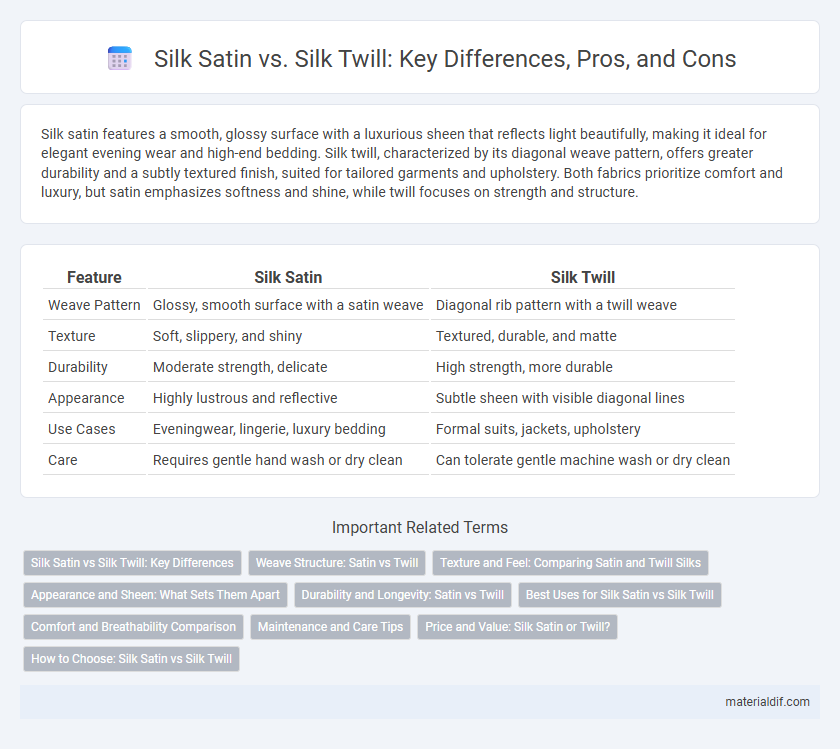Silk satin features a smooth, glossy surface with a luxurious sheen that reflects light beautifully, making it ideal for elegant evening wear and high-end bedding. Silk twill, characterized by its diagonal weave pattern, offers greater durability and a subtly textured finish, suited for tailored garments and upholstery. Both fabrics prioritize comfort and luxury, but satin emphasizes softness and shine, while twill focuses on strength and structure.
Table of Comparison
| Feature | Silk Satin | Silk Twill |
|---|---|---|
| Weave Pattern | Glossy, smooth surface with a satin weave | Diagonal rib pattern with a twill weave |
| Texture | Soft, slippery, and shiny | Textured, durable, and matte |
| Durability | Moderate strength, delicate | High strength, more durable |
| Appearance | Highly lustrous and reflective | Subtle sheen with visible diagonal lines |
| Use Cases | Eveningwear, lingerie, luxury bedding | Formal suits, jackets, upholstery |
| Care | Requires gentle hand wash or dry clean | Can tolerate gentle machine wash or dry clean |
Silk Satin vs Silk Twill: Key Differences
Silk satin is characterized by its smooth, glossy surface and high sheen, making it ideal for luxurious garments and bedding, while silk twill features a distinctive diagonal weave that provides greater durability and a matte finish. The weave structure of silk satin allows more light reflection, resulting in its signature shine, whereas the twill weave creates texture and depth, enhancing strength and wrinkle resistance. Silk satin tends to drape fluidly and is more delicate, whereas silk twill offers a sturdier fabric choice suitable for tailored clothing and upholstery.
Weave Structure: Satin vs Twill
Silk satin features a weave structure characterized by floating yarns that create a smooth, glossy surface with high reflectivity, making it ideal for luxurious clothing and bedding. Silk twill exhibits a diagonal rib pattern due to its weave, offering enhanced durability and a more textured appearance while maintaining a subtle sheen. The satin weave emphasizes luster and softness, whereas the twill weave prioritizes strength and drape, influencing the choice of fabric based on end-use applications.
Texture and Feel: Comparing Satin and Twill Silks
Silk satin features a smooth, glossy surface with a luxurious, slippery feel, resulting from its weave that reflects light beautifully. In contrast, silk twill has a distinctive diagonal rib pattern that creates a textured, matte finish offering more structure and durability. The choice between silk satin and silk twill depends on the desired tactile experience and visual effect for garments or home textiles.
Appearance and Sheen: What Sets Them Apart
Silk satin boasts a smooth, glossy surface with a high sheen that reflects light brilliantly, giving it a luxurious and elegant appearance. In contrast, silk twill features a diagonal weave pattern that results in a softer luster and a textured finish, offering a more subtle, matte look. These distinctive weave structures impact how each fabric catches light and presents its sheen, making satin ideal for formal wear and twill suited for casual yet sophisticated garments.
Durability and Longevity: Satin vs Twill
Silk twill is generally more durable and resistant to wear than silk satin due to its tightly woven diagonal rib pattern, which enhances strength and longevity. Satin's smooth, glossy surface, while luxurious, is more prone to snagging and abrasion, reducing its lifespan in high-traffic use. For applications requiring long-lasting fabric, silk twill offers superior resilience without compromising the natural sheen of silk.
Best Uses for Silk Satin vs Silk Twill
Silk satin, characterized by its glossy, smooth surface and luxurious drape, is ideal for evening gowns, lingerie, and high-end bedding due to its elegant sheen and soft texture. Silk twill, with its distinctive diagonal weave and matte finish, offers greater durability and wrinkle resistance, making it better suited for tailored garments, upholstery, and accessories like scarves and ties. Choosing between silk satin and silk twill depends on the desired aesthetic, texture, and functionality for each specific use.
Comfort and Breathability Comparison
Silk satin offers a smooth, glossy surface that feels incredibly soft against the skin, enhancing comfort with its luxurious texture. Silk twill features a distinctive diagonal weave that provides a slightly heavier fabric, improving durability while maintaining excellent breathability. Both fabrics excel in moisture-wicking, but silk satin tends to feel cooler and more breathable in warm weather due to its lighter construction.
Maintenance and Care Tips
Silk satin requires gentle hand washing with mild detergent or professional dry cleaning to maintain its smooth, glossy finish, while avoiding direct sunlight to prevent fading. Silk twill, being more textured and durable, can withstand delicate machine washes on a cold cycle, but should still be air-dried flat to preserve its weave integrity. Both fabrics benefit from low-heat ironing with a cloth barrier to prevent damage and maintain their luxurious appearance.
Price and Value: Silk Satin or Twill?
Silk satin typically commands a higher price due to its glossy finish and luxurious feel, making it a premium choice for elegant garments and bedding. Silk twill, while often more affordable, offers greater durability and a subtle texture, providing excellent value for everyday wear or items requiring resilience. Choosing between silk satin and twill depends on balancing budget constraints with the desired aesthetic and long-term use.
How to Choose: Silk Satin vs Silk Twill
Choose Silk Satin for a smooth, glossy finish that enhances luxury and drapes elegantly, ideal for formal wear and evening gowns. Opt for Silk Twill when durability and texture matter, as its diagonal weave offers a soft sheen with increased strength, perfect for tailored garments and everyday use. Consider the intended garment style, care requirements, and tactile preference when selecting between Silk Satin and Silk Twill to ensure optimal comfort and appearance.
Silk satin vs Silk twill Infographic

 materialdif.com
materialdif.com